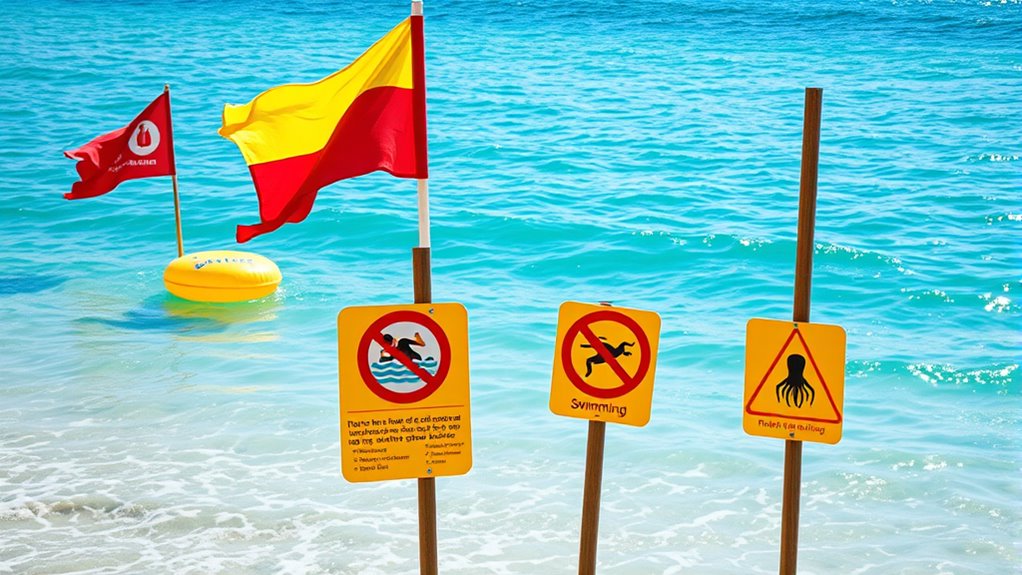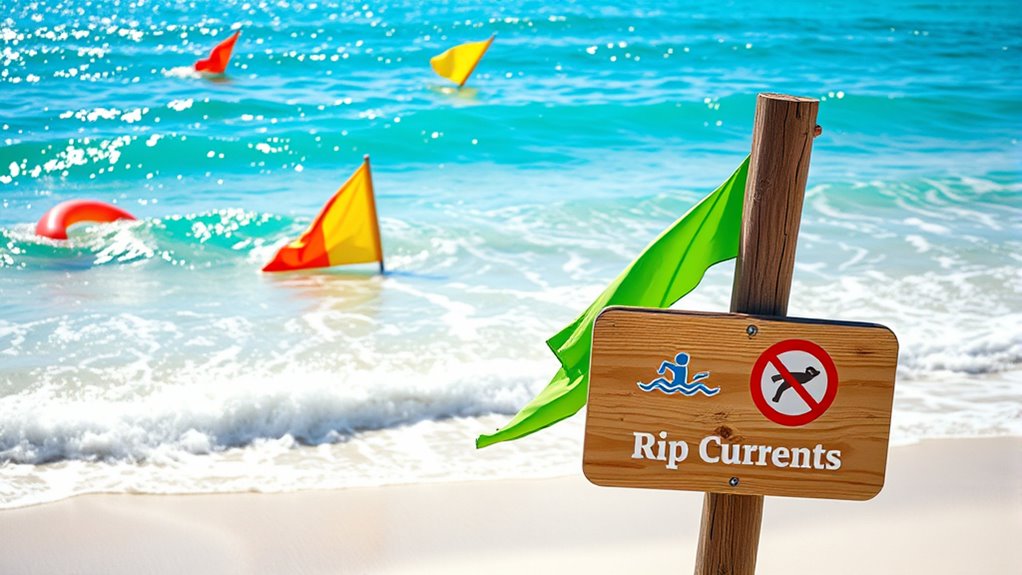Floating safety flags and beach signage communicate important water conditions and hazards you need to know. A red flag means dangerous surf or strong currents, so you should stay out of the water. Yellow flags warn of moderate hazards, while green flags indicate safe conditions, but you should still stay alert. Beach signs provide detailed safety tips and hazard information. Understanding these signals helps you stay safer and enjoy your time at the beach; there’s more to learn about their meanings below.
Key Takeaways
- Floating safety flags use standardized colors (red, yellow, green) to indicate water hazard levels and swimming conditions.
- Beach signage provides detailed instructions and warnings about water hazards, rip currents, and marine life.
- Recognizing flag meanings helps swimmers and beachgoers adjust activities and stay safe.
- Lifeguards monitor flag signals and signage to assess water conditions and coordinate rescues.
- Understanding safety signals enhances emergency response and promotes responsible behavior at the beach.

Have you ever wondered how beaches keep swimmers safe and informed? The answer often lies in the floating safety flags and beach signage that are strategically placed along the shoreline. These tools serve as visual cues, providing immediate information about current water conditions and potential hazards. When you’re enjoying a day at the beach, understanding what these signals mean can be vital for your safety and the safety of others. Recognizing the meaning behind different flags and signs helps you make quick decisions, especially when it comes to water rescue situations or avoiding dangerous areas.
Floating safety flags are designed to communicate specific conditions to swimmers and beachgoers. For example, a solid red flag might indicate dangerous surf conditions or strong currents, signaling that swimming is prohibited or hazardous. A yellow flag often warns of moderate surf or potential hazards, suggesting extra caution is needed. Green flags typically mean the water is safe for swimming, but you should still remain alert. These flags are part of hazard recognition, helping you identify dangers at a glance and adjust your activities accordingly. By paying attention to these signals, you contribute to your safety and help prevent accidents.
Red flags mean dangerous conditions; yellow flags signal caution; green flags indicate safe swimming areas.
Beach signage complements the flags by offering more detailed information about water conditions, rip currents, marine life, or other hazards. Clear, easy-to-understand signs guide you on what areas are safe for swimming and which ones to avoid. They often include instructions for what to do if you get caught in a rip current, for example, encouraging you to swim parallel to the shoreline rather than against the current. Recognizing these signs quickly can be the difference between a safe outing and a dangerous situation requiring a water rescue. If you notice a swimmer in distress, understanding the signs and flags around you can help you respond more effectively or alert lifeguards promptly. Additionally, local water parks often implement similar safety protocols, emphasizing the importance of visual cues in water safety.
Lifeguards rely heavily on these visual cues to monitor conditions and decide when to initiate a water rescue. They watch for changes in flag signals and signs that indicate worsening conditions or emerging hazards, allowing them to act swiftly. As a beachgoer, staying aware of these signals isn’t just about following rules—it’s about actively participating in your safety and the safety of others. When you respect the flags and signage, you’re acknowledging the importance of hazard recognition and helping create a safer environment for everyone. So next time you visit the beach, take a moment to familiarize yourself with the safety flags and signs. Your awareness could make all the difference in enjoying a fun, safe day by the water.
Frequently Asked Questions
How Are Floating Safety Flags Maintained and Replaced?
You maintain and replace floating safety flags by regularly inspecting them for wear, tear, or fading, especially considering beach flag colors that indicate water conditions. Follow signage maintenance schedules to guarantee flags are visible and in good condition. When a flag becomes damaged or loses its color, you promptly replace it with a new one to ensure accurate safety communication, keeping beachgoers informed and safe at all times.
What Are the Legal Responsibilities of Beach Authorities Regarding Signage?
As a beach authority, you’re responsible for signage that clearly communicates safety rules, warns of hazards, and guides visitors. You must guarantee signage compliance to avoid liability concerns, enforce regulations consistently, and maintain public safety. You’re also tasked with updating signs promptly when conditions change, providing adequate information, and ensuring visibility. By fulfilling these responsibilities, you help protect visitors, uphold legal standards, and promote a safe, enjoyable beach environment for all.
How Do Weather Conditions Affect Flag and Signage Visibility?
Weather conditions markedly impact flag and signage visibility, making it harder for you to recognize safety signals. Storms, fog, heavy rain, and strong winds create visibility challenges, blurring or obscuring these important indicators. During adverse weather patterns, you should stay alert and exercise caution, as poor visibility might delay your ability to notice safety flags or signs, increasing the risk of accidents. Always prioritize safety and heed any additional warnings issued during bad weather.
Are There International Standards for Beach Signage Symbols?
Did you know that over 50 countries follow some form of international symbol standards for beach signage? These standards aim to guarantee signage uniformity, making it easier for visitors to understand safety messages regardless of where they are. You’ll find that many beaches adopt these symbols to promote consistent communication. By doing so, they help prevent confusion and improve safety, especially for travelers unfamiliar with local language or customs.
How Can Visitors Report Damaged or Unclear Safety Signs?
You can report damaged or unclear safety signs by following the official reporting procedures provided by the beach authorities, often available on their website or at the beach entrance. Your community involvement is essential; notify lifeguards, staff, or use designated communication channels like phone hotlines or apps. This ensures quick repairs, keeps everyone safe, and helps maintain clear communication about safety conditions for all beach visitors.
Conclusion
By understanding floating safety flags and beach signage, you stay safe and enjoy your day like a seasoned sailor steering calm waters. Remember, these signals are your modern-day lighthouse, guiding you away from danger. Don’t be caught off guard—think of it as having your own personal “Jolly Roger” warning you when trouble’s near. Stay alert, obey the signs, and make every beach visit a safe adventure, just like the good old days of seaside explorers.










